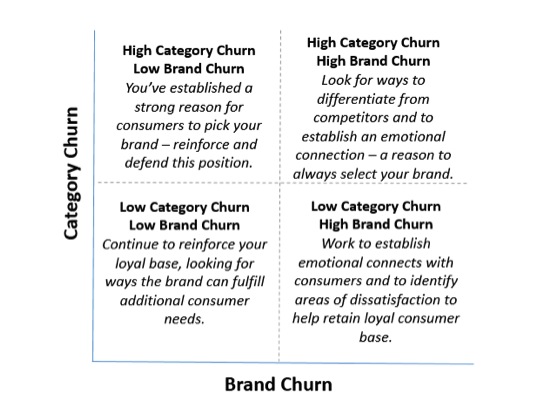The loyal customer is the Holy Grail for brands. This loyal base is relentlessly pursued, tracked, and analyzed. However, many brands often miss an important underlying dynamic that can provide significant insights.
Churn is the percentage of your customer base that is continually exiting and entering. Even if the size of a brand’s loyal base doesn’t drastically change over time, chances are there is some level of churn. Understanding if your brand operates with a high or low churn dynamic can help determine an optimal advertising strategy.
Brands with high levels of churn are continually losing customers and gaining new ones. The advertising strategy for these brands should address that the loyal base is vulnerable and the campaign needs to attract new consumers to replace those lost to competitors. Another advertising strategy for brands with high churn is establishing an emotional connection between your brand and consumers; this tactic helps build loyalty.
Conversely, brands with low churn enjoy a fairly stable customer base. Holding onto an existing customer requires different tactics than attracting new ones, and brands have to work to deepen the relationship between consumers and the brand. One key to success is looking for ways the brand uniquely fulfills both practical and emotional consumer needs, and communicating those effectively.
Some categories are characterized by inherently low or high churn. Categories with little differentiation between products, low switching costs, and low affinity are likely to experience high churn. When consumers are not highly connected to any single brand, this creates challenges for fostering brand loyalty. Conversely, in low churn categories where consumers feel strong affinity to a particular brand or where switching costs are high, the challenge lies in attracting consumers who are very loyal to a competitor and are reluctant to switch.
Focusing on what makes your brand different and relevant to consumers can help tip churn in your favor. Further, discovering category churn dynamics in relation to your own brand’s churn patterns can help refine your advertising strategy. The ideal scenario is to develop a low brand churn in a high churn category. A big opportunity to improve brand health exists in bringing high brand churn into a low churn category. Understanding your brand’s position in the advertising environment will help provide clues on how to refine messaging to be more impactful.
How have your brands evaluated and addressed brand churn dynamics? What are your favorite examples of brands that have overcome their inherent churn challenges with smart advertising?



